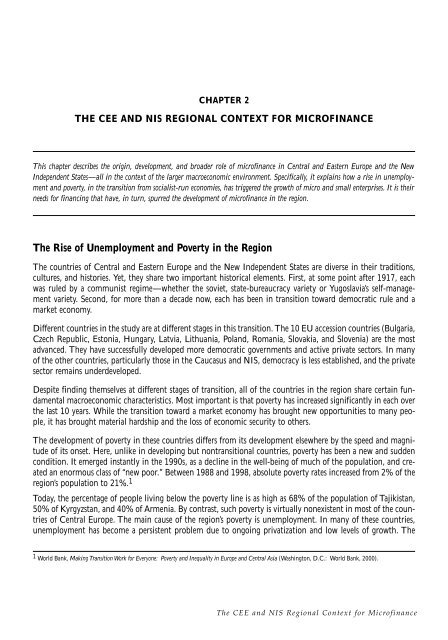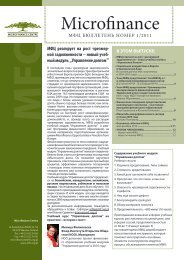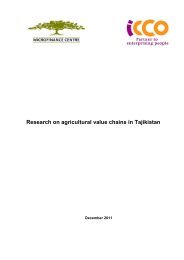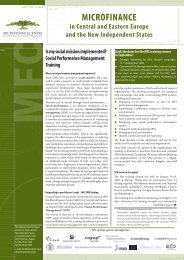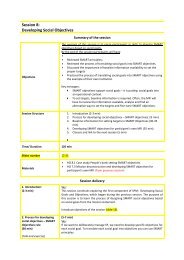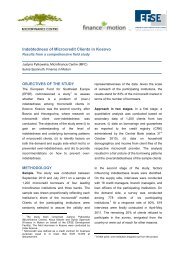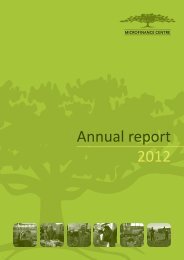In Central And Eastern Europe - Microfinance Centre
In Central And Eastern Europe - Microfinance Centre
In Central And Eastern Europe - Microfinance Centre
Create successful ePaper yourself
Turn your PDF publications into a flip-book with our unique Google optimized e-Paper software.
CHAPTER 2<br />
THE CEE AND NIS REGIONAL CONTEXT FOR MICROFINANCE<br />
This chapter describes the origin, development, and broader role of microfinance in <strong>Central</strong> and <strong>Eastern</strong> <strong>Europe</strong> and the New<br />
<strong>In</strong>dependent States—all in the context of the larger macroeconomic environment. Specifically, it explains how a rise in unemployment<br />
and poverty, in the transition from socialist-run economies, has triggered the growth of micro and small enterprises. It is their<br />
needs for financing that have, in turn, spurred the development of microfinance in the region.<br />
The Rise of Unemployment and Poverty in the Region<br />
The countries of <strong>Central</strong> and <strong>Eastern</strong> <strong>Europe</strong> and the New <strong>In</strong>dependent States are diverse in their traditions,<br />
cultures, and histories. Yet, they share two important historical elements. First, at some point after 1917, each<br />
was ruled by a communist regime—whether the soviet, state-bureaucracy variety or Yugoslavia’s self-management<br />
variety. Second, for more than a decade now, each has been in transition toward democratic rule and a<br />
market economy.<br />
Different countries in the study are at different stages in this transition. The 10 EU accession countries (Bulgaria,<br />
Czech Republic, Estonia, Hungary, Latvia, Lithuania, Poland, Romania, Slovakia, and Slovenia) are the most<br />
advanced. They have successfully developed more democratic governments and active private sectors. <strong>In</strong> many<br />
of the other countries, particularly those in the Caucasus and NIS, democracy is less established, and the private<br />
sector remains underdeveloped.<br />
Despite finding themselves at different stages of transition, all of the countries in the region share certain fundamental<br />
macroeconomic characteristics. Most important is that poverty has increased significantly in each over<br />
the last 10 years. While the transition toward a market economy has brought new opportunities to many people,<br />
it has brought material hardship and the loss of economic security to others.<br />
The development of poverty in these countries differs from its development elsewhere by the speed and magnitude<br />
of its onset. Here, unlike in developing but nontransitional countries, poverty has been a new and sudden<br />
condition. It emerged instantly in the 1990s, as a decline in the well-being of much of the population, and created<br />
an enormous class of “new poor.” Between 1988 and 1998, absolute poverty rates increased from 2% of the<br />
region’s population to 21%. 1<br />
Today, the percentage of people living below the poverty line is as high as 68% of the population of Tajikistan,<br />
50% of Kyrgyzstan, and 40% of Armenia. By contrast, such poverty is virtually nonexistent in most of the countries<br />
of <strong>Central</strong> <strong>Europe</strong>. The main cause of the region’s poverty is unemployment. <strong>In</strong> many of these countries,<br />
unemployment has become a persistent problem due to ongoing privatization and low levels of growth. The<br />
1 World Bank, Making Transition Work for Everyone: Poverty and <strong>In</strong>equality in <strong>Europe</strong> and <strong>Central</strong> Asia (Washington, D.C.: World Bank, 2000).<br />
The CEE and NIS Regional Context for <strong>Microfinance</strong>


